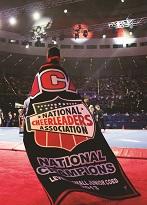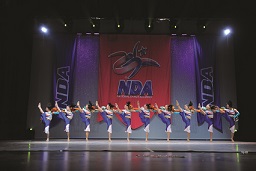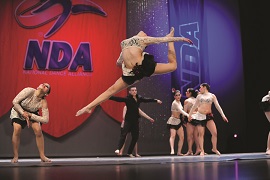
Cheerleading has changed through the years, and so has dance. I like to think they’ve changed for the better, meaning, of course, the athletes stay safer – but there have been many other aspects of this evolution as well. Here at the American Association of Cheerleading Coaches and Administrators (AACCA), we have a unique perspective on the sports: what they mean to participants, what they mean to officials and what they mean to spectators.
Members of our organization include youth, junior high school, high school, all-star and college or university coaches/advisors, as well as national cheerleading instructional companies. Here are a few things I, as executive director, have learned from those members.

Although we hear a lot about Title IX, here at AACCA, we’re not really seeing it as a negative factor in participation. In terms of schools, each state governs their sports independently. In most school settings, cheer is viewed as an athletic activity, while some other jurisdictions label it as a sport. When they do that, it is mainly so that the local high school athletic association is able to set rules regarding training and safety. Regardless, cheer in a school allows kids to get involved and support the school. They also serve in a leadership role, encouraging the crowd during sports functions.
As mentioned previously, AACCA serves a wide range of member organizations, some of which are all-star cheer organizations. Because those are private or club organizations, they are not subject to the same rules as schools, so Title IX is not a factor.
Evolution of the All-Star Cheer Program
What is interesting is the fact that the all-star cheer organizations and gyms actually came about because of the popularity of cheerleading. High schools are generally limited in the number of kids who can participate in a cheer squad. They may have 16 openings, and 30, 40 or more students trying out.
About 20 years ago, there was this realization that a lot of kids still wanted to cheer, even though they didn’t make it, so these private programs, known as all-star cheerleading, were formed. They were an outlet for kids who did not get onto their school team.
These days, all-star cheer has taken on a separate identity. In those organizations, there’s no limit to the number of participants. The club can just keep on creating teams to accommodate the enrollment. We’re seeing cheer gyms with at least 100, sometimes 500, kids enrolled, and all those kids participating.
The larger facilities and programs are what actually helped drive and grow the industry of competitive cheer events. Since the kids in all-star groups don’t have to cheer at school games, their schedule is open for the competitions that are being held. As a result, the competitive aspect is their focus, and they’ll do three, four, five, six or more competitions easily during the course of a year.
In high school cheer squads, kids might compete once or twice a year, but generally, that’s not their primary function. What’s interesting is that now there are kids having to make the decision of whether to participate in all-star cheer and compete, or participate in the school squad and cheer at games. It’s not always an easy decision for them.

These days, many of the expansions we have noticed in cheerleading are also taking place in competitive dance. And in many ways, dance is similar to the all-star cheer programs. It has private organizations, meaning the dance studios, and those teach kids to dance, and help them continue to develop their skills.
While most schools have dance teams of some sort, the style will vary. We like to say it is very regionalized; the style of dance you’ll see has a lot to do with where the school is, what its traditions are and what its student body likes to do. For example, some schools traditionally have had more of a drill team or kick line that performs on the field along with the band, and some have more of a pom squad that actually appears at games and cheers for teams the way the cheerleaders do. Then there are schools that might have a hip-hop dance group, or one with more of a jazz or lyrical style, with the technical elements of dance. Some groups use props, either small or large, while others don’t. There really is a lot of variety, and you can’t easily compare school teams because they are so different.
Something we’re starting to see is a rise in all-star programs that offer both cheer and dance. That generally happens because a cheer program, for example, will go to a competition, and see the dance groups performing. They’ll realize they have a facility that would work for dance as well, and they’ll start thinking about expanding their program.
We’re actually starting to see competitive dance evolve too. Just as we’ve seen cheerleading taking in more precision group routines, we’re seeing some dance groups incorporating low-level lifts and building skills. For a long time, those kinds of moves were banned in dance.
Despite this, I think .cheer and dance will continue to maintain their separate identities. They are similar in that both involve performance, and both involve athleticism and grace in body movements, but they definitely attract different types of athletes. They have, and will continue to have, some crossover elements, but they serve different purposes.

Up until now, we’ve talked a lot about the evolution of cheer and dance. There’s no doubt that both have changed over the years, and that they’re getting a lot more attention. In the 1970s and 1980s, for example, there was a lot of regionalized cheer, but not a lot of regulation or consistency. As a result, you might have an area where kids were doing incredibly advanced acrobatic moves, while in the next state over, the squad was still just standing on the sidelines and cheering for the team. But when the ESPN cameras started coming in and kids in one area saw the really elaborate things another team was doing, they all wanted to try them. There weren’t any safety guidelines and little formal instruction, and that was leading to injuries. It didn’t help either that often, the person who was the school’s cheer coach might also be the history teacher and had no background at all in cheer.
The AACCA was formed because we believe safety is paramount. Safety comes from proper training of both coaches and athletes. Parents are entrusting their kids to you as a coach, so we work to create a standard of care to minimize those injuries that used to happen all the time. We work with cheerleading and dance groups across the country and we offer an online safety course – we really believe it’s the first thing you should do as a coach: learn how to be a coach.
Our organization was formed in 1987, and today we have a membership that includes over 70,000 cheerleading and dance coaches across the United States. We are dedicated to the safe and responsible practice of student cheer and dance.
We were able to regulate the kinds of moves that cheerleaders could do at different age groups and levels of competition. The kinds of things that were being done by kids in the 1970s and ‘80s – well, let’s just say we don't let them do that now! We also teach people how to get athletes to demonstrate low-level skills before they are allowed to move on and do the more advanced moves. We also teach people how to run try-outs, how to do fund-raising, generally all the things they used to have to figure out on their own.
The cheer and dance industry has evolved because people keep learning. We like helping them learn. There’s no doubt that learning proper risk management and learning proper techniques in everything makes people into better coaches. Just as importantly, though, it makes them into people who want to stay in it. That’s better for the athletes, who have a better and safer experience.

